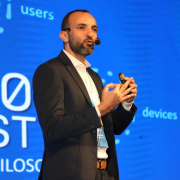

IBM Security QRadar and Sophos MDR are leading products in the cybersecurity industry, competing primarily in the domain of threat detection and response solutions. IBM Security QRadar holds a notable advantage in scalability and broad analytics visibility, while Sophos MDR stands out for its comprehensive endpoint protection and integration capabilities with centralized management.
Features: IBM Security QRadar impresses with extensive threat hunting, offering detailed data enrichment and seamless integrations. Its comprehensive platform provides broad analytics visibility and excellent scalability, along with efficient log management. Sophos MDR shines with its integration and endpoint protection, featuring centralized control and a strong focus on real-time threat hunting. It provides substantial coverage and complements firewall protection to mitigate diverse cyber threats.
Room for Improvement: IBM Security QRadar could enhance its reporting and improve integration capabilities, with a focus on user experience for smoother operations. Users also desire better API access and clearer alerting mechanisms. Sophos MDR users seek more intuitive reporting, cost optimization due to its perceived expense, and enhanced AI features. Broader third-party integration and resource optimization are also desired responsibilities for Sophos MDR.
Ease of Deployment and Customer Service: IBM Security QRadar offers versatile deployment across on-premises, public, and hybrid clouds, but users have mixed experiences with its technical support, mentioning delays and uneven support quality. Conversely, Sophos MDR is praised for its straightforward installation and deployment across diverse cloud environments, receiving generally positive feedback for its customer service known for quick response times and effective support via email, especially in infrastructure management.
Pricing and ROI: IBM Security QRadar is often seen as expensive, particularly for small enterprises, but it offers substantial value in features and scalability. Though costly upfront, it is perceived to provide long-term ROI in security investment. Meanwhile, while considered pricey by some, Sophos MDR is regarded as reasonably priced for its comprehensive protection level, with cost efficiencies emerging in larger deployments. Sophos MDR offers pricing flexibility, maintaining competitiveness in security ROI.
With SOAR, the workflow takes one minute or less to complete the analysis.
AWS gives the chance to implement a solution out of the box with use cases that are already in IBM Security QRadar.
I have seen a return on investment; I can share that it includes time saved, money saved, and fewer employees needed.
It allows them to have access to a SOC-like service without the associated costs.
On average, these claims are 97.5% lower compared to those relying solely on endpoint protection.
They assist with advanced issues, such as hardware or other problems, that are not part of standard operations.
Support needs to understand the issue first, then escalate it to the engineering team.
The support is really good; for instance, if a critical ticket is submitted, you will get paged right away as it gets logged, and their analyst will look into it, letting you know as soon as possible so you can work on it.
Sophos offers different support levels depending on the severity of the issues, which ensures timely assistance.
I would rate the technical support by Sophos at nine point five out of ten.
For EPS license, if you increase or exceed the EPS license, you cannot receive events.
IBM Security QRadar's scalability is great; you can have a new collector to deploy if you have increased EPS per second.
Users have noted that the solution can easily scale to accommodate an increasing number of protected devices without the need for redeployment.
Sophos MDR seems to have no limitations on scalability.
On cloud, you don't see any disconnections or instability.
I think QRadar is stable and currently satisfies my needs.
The product has been stable so far.
The continuous monitoring and quick incident response provided by Sophos MDR help catch potential threats early, minimizing downtime and keeping data safe.
I would rate the stability as very reliable.
We receive logs from different types of devices and need a way to correlate them effectively.
If AI-related support can suggest rules and integrate with existing security devices like MD, IPS, this SIM can create more relevant rules.
IBM Security QRadar does not support Canvas, so we had to create custom scripts and workarounds to pull logs from Canvas.
Introducing more detailed and customizable reporting and analytics features could help organizations better understand their security posture and the effectiveness of the MDR service.
Splunk is more expensive than IBM Security QRadar.
It was costly mainly because of the value you can get right now compared to other solutions.
It depends on how much you want to spend.
The solution is cost-efficient, especially for small customers who cannot justify the expense of setting up an internal SOC.
The pricing of Sophos MDR is reasonable and competitive, scoring about nine out of ten.
Recently, I faced an incident, a cyber incident, and it was detected in real time.
IBM Security QRadar gives the opportunity to improve the time to market of the releases with a great evaluation of cybersecurity breaches.
Compared to ArcSight, Splunk, or any other SIEM tools where you need their processing language such as structured query language, SPL, and in Sentinel there is KQL query languages, IBM Security QRadar doesn't require reliance on query languages.
The important features of Sophos MDR include detection and response capabilities.
The most valuable feature of Sophos MDR is that it offers a monitoring service directly from the OEM, which is beneficial for SMB customers who cannot afford a SOC.
| Product | Market Share (%) |
|---|---|
| Sophos MDR | 4.4% |
| IBM Security QRadar | 1.0% |
| Other | 94.6% |


| Company Size | Count |
|---|---|
| Small Business | 91 |
| Midsize Enterprise | 39 |
| Large Enterprise | 105 |
| Company Size | Count |
|---|---|
| Small Business | 23 |
| Midsize Enterprise | 4 |
| Large Enterprise | 7 |
IBM Security QRadar (recently acquired by Palo Alto Networks) is a security and analytics platform designed to defend against threats and scale security operations. This is done through integrated visibility, investigation, detection, and response. QRadar empowers security groups with actionable insights into high-priority threats by providing visibility into enterprise security data. Through centralized visibility, security teams and analysts can determine their security stance, which areas pose a potential threat, and which areas are critical. This will help streamline workflows by eliminating the need to pivot between tools.
IBM Security QRadar is built to address a wide range of security issues and can be easily scaled with minimal customization effort required. As data is ingested, QRadar administers automated, real-time security intelligence to swiftly and precisely discover and prioritize threats. The platform will issue alerts with actionable, rich context into developing threats. Security teams and analysts can then rapidly respond to minimize the attackers' strike. The solution will provide a complete view of activity in both cloud-based and on-premise environments as a large amount of data is ingested throughout the enterprise. Additionally, QRadar’s anomaly detection intelligence enables security teams to identify any user behavior changes that could be indicators of potential threats.
IBM QRadar Log Manager
To better help organizations protect themselves against potential security threats, attacks, and breaches, IBM QRadar Log Manager gathers, analyzes, preserves, and reports on security log events using QRadar Sense Analytics. All operating systems and applications, servers, devices, and applications are converted into searchable and actionable intelligent data. QRadar Log Manager then helps organizations meet compliance reporting and monitoring requirements, which can be further upgraded to QRadar SIEM for a more superior level of threat protection.
Some of QRadar Log Manager’s key features include:
Reviews from Real Users
IBM Security QRadar is a solution of choice among users because it provides a complete solution for security teams by integrating network analysis, log management, user behavior analytics, threat intelligence, and AI-powered investigations into a single solution. Users particularly like having a single window into their network and its ability to be used for larger enterprises.
Simon T., a cyber security services operations manager at an aerospace/defense firm, notes, "The most valuable thing about QRadar is that you have a single window into your network, SIEM, network flows, and risk management of your assets. If you use Splunk, for instance, then you still need a full packet capture solution, whereas the full packet capture solution is integrated within QRadar. Its application ecosystem makes it very powerful in terms of doing analysis."
A management executive at a security firm says, "What we like about QRadar and the models that IBM has, is it can go from a small-to-medium enterprise to a larger organization, and it gives you the same value."
Threat Notification Isn’t the Solution – It’s a Starting Point
Other managed detection and response (MDR) services simply notify you of attacks or suspicious events. Then it’s up to you to manage things from there.
With Sophos MTR, your organization is backed by an elite team of threat hunters and response experts who take targeted actions on your behalf to neutralize even the most sophisticated threats.
We monitor all Managed Detection and Response (MDR) reviews to prevent fraudulent reviews and keep review quality high. We do not post reviews by company employees or direct competitors. We validate each review for authenticity via cross-reference with LinkedIn, and personal follow-up with the reviewer when necessary.